You might be asking, “if you have the English version of Atelier Meruru, why would you buy it again on the Vita, but in Japanese?” The answer is that I find the game addictive, but I want to play it on the go. This is where the Plus version comes in as it brings the full game with the DLC included, costumes and extra scenes. Since I use my Vita mainly to practice my Japanese skills, it’s one of the main reasons I bought this game. (Image Source)
Note: Like with all the Arland games, the Plus versions were rereleased on the PlayStation 4 and Nintendo Switch as DX on September 20, 2018. As with the Plus version, the review will cover the DX versions as well.
The story for the game is pretty simple. Apparently, the small kingdom named Arls (アルーズ) will be merged into the Arland Republic. It’s your job to develop the kingdom into a big city using alchemy.
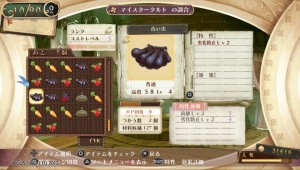
Compared to Totori Plus, Meruru Plus didn’t have too many bugs outside of the inability to build the archives because the event won’t trigger in a New Game Plus. In addition, I had the game crash after I installed the recent patch when I try to make something. Otherwise, from a gameplay perspective, Meruru improves a lot. Now, new items are a lot easier to make as they are now organized in separate categories instead of being bunched up in 4 categories in Totori. In addition, it’s easier to find the right ingredients with the right characteristics using the filter menu. This is one the aspects that reduces the frustrations of getting the right effects for the end product.
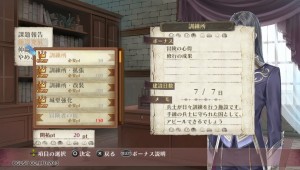
Instead of doing tasks to earn points for your Adventurer License, you have to make items, beat bosses, etc. to earn development points. From these points, you can build facilities, each one does different things. In addition, you have to do Front Quests to keep your popularity up so the population grows. It’s pretty simple unless you really neglect it that badly that you bring it down to 0, which will give you an automatic Game Over. Otherwise, the tasks are the same, but for a different purpose.
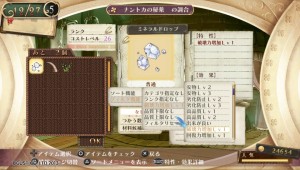
The game lasts for 5 in-game years just like Totori, which means you have to manage your time carefully. After 5 years are up, the ending is determined by what you did in the game and if you fail to meet those requirements, you will get the bad ending. When you beat the game, all your equipped weapons and development items will be carried over, thus making the second play through a lot easier.

As for the battle system, not much has changed except the assist system and skills. Instead of separate higher-level and stronger counterparts of certain items like a bomb or globe, the assist system now allows Meruru to power up attack items to deal more damage as long you have enough assists for each character and the item. Also, there are now four skills for each character instead of the two in the previous game. But aside from that, the later bosses can get really difficult such as the Airshafter, which can be just as hard as Evil Face in the previous games.
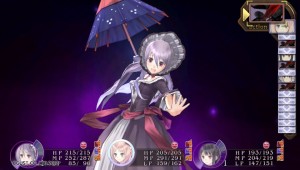
Lastly, there are some changes on how registered items and weapons are handled. For starters, Pamela’s shop is the only place you can register items compared to various shops in Totori. While you can’t register development items, you can now register ingots and cloths. This will basically make weapon and armor creation easier as they require two ingredients in order to make them. The advantage to this is that you can add the desired characteristics a lot easier.
On the other hand, Homs replaces the Chims from Totori. This means that you cannot duplicate any item such as an ingredient. However, you can use them to make items and gather ingredients, which makes it slightly more useful as you don’t have to keep duplicating pies to make them work.
Meruru Plus/DX Additional Features
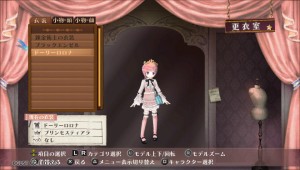
In Totori Plus/DX, you could now change the outfits that Totori wore such as a nurse or maid’s outfit. Now, this feature is expanded to all three main alchemists (Meruru, Totori and Rorona) in the game. In addition, there is also an option to add accessories to the character’s face. From the start, you can change Meruru’s costume to Rorona’s or Totori’s clothes, but you can expand the selection by building the Boutique and beating the game for the first time or get other endings.
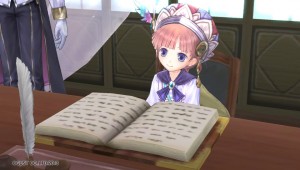
In addition to the costumes, there is the DLC, which features music from other Gust games, additional characters and an after game dungeon, which you should already be familiar with. Of course, the additional characters are the best part of the DLC as you can have Rufus, Fwana and Pamela to join your team. Out of the three, I use Pamela a lot because she is funny and really powerful when equipped with her third weapon. In addition, she can revive herself automatically when she is knocked out, which means that you don’t have to waste nectar on her. It makes sense she is a ghost after all. Still, I don’t really use Rufus as I prefer female characters and there are already a lot of male characters hogging the spotlight in JRPGs.
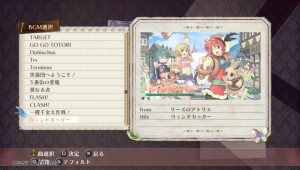
Lastly, there are some adjustments and balancing in the Vita/Playstation 4/Nintendo Switch version to make the game easier. This includes new special effects, a bit more defense, less development points needed to build stuff and so on. In addition, there is one additional event, which I won’t spoil and changes to one ending scene.
Conclusion
Overall, I thought Meruru was an improvement over Totori in terms of gameplay. Story wise, it’s more lighthearted compared to the last game, which had a good amount of melodrama when Totori finds out that her mother died when she fought against Evil Face (although, her mother was alive all along in the true ending). Still, I still hear some complaints over turning Rorona into an 8-year-old child. To me, I don’t see it as a big deal since it’s something really minor.
Aside from that, the port of this game and Totori shows how capable the Vita actually is, more so on the Playstation 4 and Nintendo Switch ports. Both games have gorgeous looking graphics and on par with the Playstation 3 versions despite having some lag in some instances. Still, the music in this game is probably one of the best I heard from any RPG. So, if this kind of game interests you and you know some Japanese, just get the Vita or the newer Playstation 4/Nintendo Switch versions since there is a good possibility that they won’t localize this and you will get more content for your money compared to buying the DLC separately.

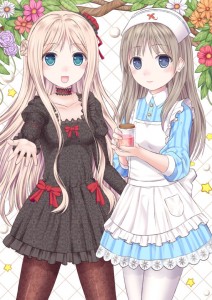

I guess the debate between Totori vs Meruru continues. Some liked Totori more. I dunno, both gave me Totori X Mimi so why should I bother comparing when Meruru is a continuation of their blossoming love story.
Anyway, I don’t own a Vita so for now, console version it is. The bonus content never was enough to make me pick Portable versions of NIS or Gust games.
While I have played both games quite a lot, I still enjoy most of the characters in the trilogy… Of course, Mimi is one of my favorites, but I also like Totori and her older sister, Pamela and Filly. Sterk is probably the only playable male character I like, but my preference is mostly towards female characters.
Either way, if someone is really a diehard fan or just own a portable console, the portable versions are good… Even if I owned the Plus versions, I didn’t sold my PS3 version for the fact that you can’t output the game to a TV, meaning you can’ use a capture card and sometimes, I like playing video games on the big screen. But compared to the old games which I own one of them, the Arland games have easier gameplay and still has alot of depth with the characteristics and quest while maintaining the classic gameplay. Probably one of these days, I’ll go buy Ayesha in Japanese when the Best versions come out as I’m not too fond of the dub only approach Komei-Techmo are taking as they now own Gust. Oh well, the newest Atelier game they are making looks more interesting from a gameplay perspective as I heard that you can use 6 people or something in battle and it has 2 main characters in that game.